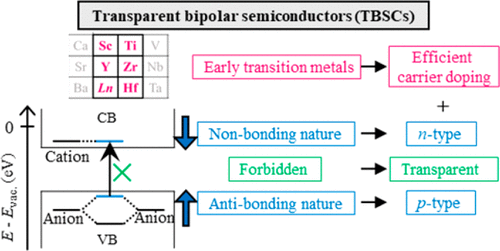当前位置:
X-MOL 学术
›
J. Am. Chem. Soc.
›
论文详情
Our official English website, www.x-mol.net, welcomes your feedback! (Note: you will need to create a separate account there.)
Chemical Design and Example of Transparent Bipolar Semiconductors
Journal of the American Chemical Society ( IF 15.0 ) Pub Date : 2017-11-17 00:00:00 , DOI: 10.1021/jacs.7b09806 Takeshi Arai 1 , Soshi Iimura 1 , Junghwan Kim 2 , Yoshitake Toda 2 , Shigenori Ueda 3, 4 , Hideo Hosono 1, 2
Journal of the American Chemical Society ( IF 15.0 ) Pub Date : 2017-11-17 00:00:00 , DOI: 10.1021/jacs.7b09806 Takeshi Arai 1 , Soshi Iimura 1 , Junghwan Kim 2 , Yoshitake Toda 2 , Shigenori Ueda 3, 4 , Hideo Hosono 1, 2
Affiliation

|
Transparent bipolar semiconductors (TBSCs) are in demand for transparent electronics to serve as the basis for next generation optoelectronic devices. However, the poor carrier controllability in wide-bandgap materials makes the realization of a bipolar nature difficult. Only two materials, CuInO2 and SnO, have been reported as TBSCs. To satisfy demand for the coexistence of transparency and bipolarity, we propose a design concept with three strategies; choice of early transition metals (eTM) such as Y3+ and Zr4+ for improving controllability of carrier doping, design of chemical bonds to obtain an appropriate band structure for bipolar doping, and use of a forbidden band-edge transition to retain transparency. This approach is verified through a practical examination of a candidate material, tetragonal ZrOS, which is chosen by following the criteria. ZrOS exhibits an excellent controllability of the electrical conductivity (10–7–10–2 S cm–1), p- or n-type nature with ∼10–2 S cm–1 by Y or F doping, respectively, and optically wide gap (below 10–4 cm–1 up to ∼2.5 eV). This concept provides a new kind of TBSC based on eTM ionic compounds.
中文翻译:

透明双极半导体的化学设计和实例
透明双极半导体(TBSC)要求透明电子器件作为下一代光电器件的基础。然而,宽带隙材料中较差的载流子可控性使得实现双极性质变得困难。据报道只有两种材料CuInO 2和SnO作为TBSC。为了满足对透明性和双极性共存的需求,我们提出了一种具有三种策略的设计概念:选择早期过渡金属(eTM),例如Y 3+和Zr 4+为了改善载流子掺杂的可控制性,设计化学键以获得用于双极掺杂的合适的能带结构,并使用禁带边缘跃迁来保持透明性。通过对候选材料四方ZrOS进行实际检查来验证此方法,该材料是根据标准选择的。ZrOS表现出极好的电导率可控性(10 –7 –10 –2 S cm –1),p型或n型性质,分别通过Y或F掺杂达到〜10 –2 S cm –1,并且光学上较宽间隙(低于10 –4厘米–1高达约2.5 eV)。该概念提供了一种基于eTM离子化合物的新型TBSC。
更新日期:2017-11-19
中文翻译:

透明双极半导体的化学设计和实例
透明双极半导体(TBSC)要求透明电子器件作为下一代光电器件的基础。然而,宽带隙材料中较差的载流子可控性使得实现双极性质变得困难。据报道只有两种材料CuInO 2和SnO作为TBSC。为了满足对透明性和双极性共存的需求,我们提出了一种具有三种策略的设计概念:选择早期过渡金属(eTM),例如Y 3+和Zr 4+为了改善载流子掺杂的可控制性,设计化学键以获得用于双极掺杂的合适的能带结构,并使用禁带边缘跃迁来保持透明性。通过对候选材料四方ZrOS进行实际检查来验证此方法,该材料是根据标准选择的。ZrOS表现出极好的电导率可控性(10 –7 –10 –2 S cm –1),p型或n型性质,分别通过Y或F掺杂达到〜10 –2 S cm –1,并且光学上较宽间隙(低于10 –4厘米–1高达约2.5 eV)。该概念提供了一种基于eTM离子化合物的新型TBSC。



























 京公网安备 11010802027423号
京公网安备 11010802027423号